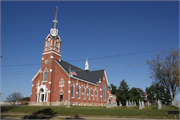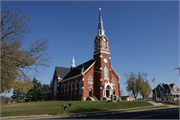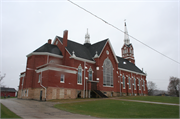Property Record
36028 OSSEO RD
Architecture and History Inventory
| Historic Name: | SAINTS PIOTRA I PAWLA KOSCIOL |
|---|---|
| Other Name: | SAINTS PETER AND PAUL ROMAN CATHOLIC CHURCH |
| Contributing: | |
| Reference Number: | 49654 |
| Location (Address): | 36028 OSSEO RD |
|---|---|
| County: | Trempealeau |
| City: | Independence |
| Township/Village: | |
| Unincorporated Community: | |
| Town: | |
| Range: | |
| Direction: | |
| Section: | |
| Quarter Section: | |
| Quarter/Quarter Section: |
| Year Built: | 1896 |
|---|---|
| Additions: | 1907 |
| Survey Date: | 19952010 |
| Historic Use: | church |
| Architectural Style: | Early Gothic Revival |
| Structural System: | |
| Wall Material: | Brick |
| Architect: | Henry Laycock; Schick and Roth-1907 |
| Other Buildings On Site: | |
| Demolished?: | No |
| Demolished Date: |
| National/State Register Listing Name: | Not listed |
|---|---|
| National Register Listing Date: | |
| State Register Listing Date: |
| Additional Information: | A 'site file' exists for this property. It contains additional information such as correspondence, newspaper clippings, or historical information. It is a public record and may be viewed in person at the State Historical Society, Division of Historic Preservation. 2011-The Saints Peter & Paul Catholic Church is an imposing Neo-Gothic Revival style brick church located on the east side of Osseo Road, north of its intersection with Whitehall Road. Erected in 1895-96, the previously inventoried church sits on a small rise overlooking Osseo Road. Oriented perpendicular to the roadway, it is laid out in a cruciform plan and rests on a rock-faced, coursed and cut-stone foundation. Perhaps the most striking feature of the main (westfacing) facade is the central entrance located on the projecting bell tower. The bell tower pierces the roof and is topped with a steeple that is crowned with a cross. The main facade also displays three doorways, the central main entrance and two flanking side entrances. The main entrance features a classically-inspired, gothic-arched entrance supported by smooth embellished columns. The two smaller side entrances are surmounted with decorative brick hoods trimmed with stone molding. Brick corbelling, stepped buttresses, stone sills, finials, gothic-arch and circle windows, and stained glass embellish the church. The Nee-Gothic Revival style of the church is reflected in its smooth brick walls with stone trim, finials, buttresses, and pointed-arch stained glass. The rear (east-facing) portion of the church, a polygonal apse with one-story wings, was constructed in 1982 and was built of matching materials. Alterations to the church are limited to its doors, which were replaced in the 1970s. The church retains its historic integrity with few alterations. The organization of the Saints Peter & Paul Catholic Church in 1869 was a direct result of the growing numbers of Polish Catholics immigrating to the area, many of which came from Poppeleau, Upper Silesia, Prussia. Like most churches in early years, the parish had no particular meeting place, and spiritual needs were met by visiting priests who periodically conducted services in various private homes. In 1875, however, George H. Markham and his brother Arthur donated acreage for the construction of the church, and in October of that year, the parish's first edifice, a frame building, was dedicated by the late Bishop Michael Heiss of the La Crosse Diocese. The present edifice was erected in 1895-96. A rear addition in 1907 enlarged the church. The addition made the church the largest in the diocese of La Crosse, with a seating capacity of 1,200. By 1917, the parish had grown to over 425 families. The continued growth of the church led to the construction of other religious buildings on adjacent land, including a convent (1901/1932), a rectory (1915), and a school (1967) (discussed later). The school was preceded by two earlier versions that have since been demolished. A cemetery associated with the parish is located directly south of the church, and dates from the late nineteenth century. The church is significant for its Polish cultural association. The church was founded by immigrants from Poland who began arriving in Trempealeau County in the 1860s. As with most cultures, the church is the cornerstone of the community and vital in preserving cultural identity; the Saints Peter & Paul Catholic Church is no exception. The church is an excellent and intact example of a Neo-Gothic Revival style church in Trempealeau County. Reputedly, it is said to be modeled after a church in Poppeleau, Silesia, Upper Prussia, where many of the first Independence Polish Catholic immigrants originated. Additionally, the church also includes three other key buildings with good integrity - a convent, rectory and school. Neogothic Revival style design; brick corbelling, brick buttresses, stone sills, finials, gothic-arch and circle windows, and stained glass; exterior sandblasted in 1960s; very few alterations - new roof in 2010, 1970s storm window additions, and doors date between the 1940s and 1970s. The church maintains remarkable architectural integrity. Complex includes church, rectory, convent & school The parish was initially organized in 1869 as a direct response to the large number of Polish Catholics immigrating to the area, the majority of which came from Poppeleau, Upper Silesia, Prussia. During these early days, the parish had no particular meeting place, and spiritual needs were met by visiting priests who periodically conducted services in various private homes. In 1875, George H. Markham and his brother Arthur donated acreage for the construction of a church; in October of that year, the parish's first edifice, a frame building, was dedicated by the late Bishop Michael Heiss of the La Crosse Diocese. The present edifice was erected in 1896. A rear addition in 1907 enlarged the church. The addition made the church the largest in the diocese of La Crosse, with a seating capacity of 1,200. By 1917, the parish had grown to over 425 families. The continued growth of the church led to the construction of other religious buildings on adjacent land, including a rectory/convent (1889/1901), a rectory (1915), and a school (1966). The school was preceded by two earlier versions that have since been demolished. A cemetery associated with the parish is located directly south of the church, and dates from the late nineteenth century. |
|---|---|
| Bibliographic References: | HAUK, JOSEPH L. 1917 "CATHOLIC CHURCH IN TREMPEALEAU CO." HISTORY OF TREMPEALEAU CO., WIS., PP. 461-922, COMPILED BY FRANKLIN CURTISS-WEDGE, EDITED BY EBEN S. DOUGLAS PIERCE. H.C. COOPER, JR. & CO., CHICAGO AND WINONA, P. 84. INDEPENDENCE NEWS WAVE 6/13/1996. ARCADIA NEWS LEADER 7/3/1996. Gamroth, Clarence J. (Ed.). Historical Album, 100 Years, Independence, Wisc. Independence, WI: City of Independence, 1976. Buildings of Wisconsin manuscript. The Improvement Bulletin 3/2/1907. |
| Wisconsin Architecture and History Inventory, State Historic Preservation Office, Wisconsin Historical Society, Madison, Wisconsin |





